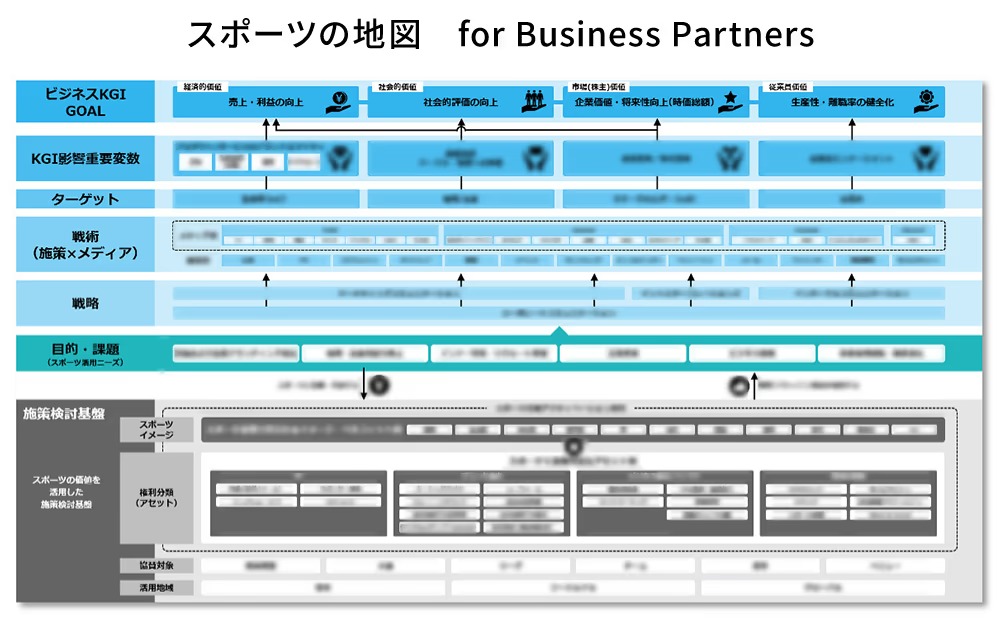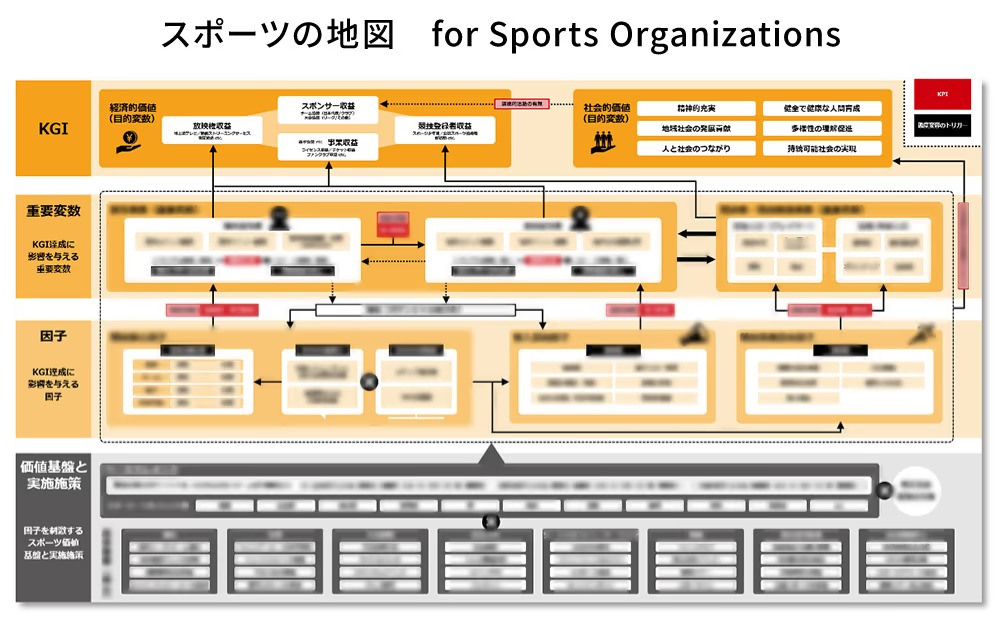Note: This website was automatically translated, so some terms or nuances may not be completely accurate.
What is the "Sports Map" that visualizes the "value of sports" for companies, sports organizations, and consumers?
Dentsu Inc. developed the strategic framework "Sports Map ver1.0" (hereinafter referred to as the Sports Map) to support the business growth of sports organizations such as competitive bodies, leagues, and clubs, as well as companies utilizing sports for marketing. This framework aims to create compelling experiences and circulate value back to consumers.
This article features a discussion among the members who developed the Sports Map, covering challenges faced by sports content and organizations, the background and key points of the Sports Map's development, and examples of its application.

A map is needed to share the value of sports across the entire company
Kawahori: First, introductions. I belong to Dentsu Inc.'s Sports Business Solution Division (SBS Bureau). The SBS Bureau is an organization that collaborates with stakeholders to create various values for society through sports.
Nakakita: I'm also part of the SBS Division. I work with companies utilizing sports for marketing and sports organizations, planning data-driven marketing strategies and initiatives.
Hayashi: I belong to Marketing Division 5, working on business strategy and marketing-related areas. I handle many sports-related projects, supporting corporate marketing utilizing sports and consulting on business strategies for sports organizations.
Kawahori: This time, members of the SBS Division, marketers like Hayashi who handle sports-related projects, and external consultants came together to create a sports map. First, I'd like to revisit how corporate use of sports for marketing has evolved.
I understand there have been four major phases. Initially, involvement was largely donation-based, centered around financial support. As sports grew, exposure value emerged—such as corporate signage and logos appearing on TV—leading to sports being viewed as a media platform. By the 2000s, cases increased where sports were utilized beyond mere media, for marketing purposes, including creating merchandise and running promotional campaigns.
Recently, attention has shifted to the inherent values of sports, such as fostering social connections and community bonds. This has given rise to a perspective that utilizes sports not only for marketing but also for social contribution and addressing societal challenges. Consequently, the purposes for which companies utilize sports are diversifying.
In today's era, the "Integrated Reporting ver1.0" (overview available at here ), companies must not only generate profits but also create value for diverse stakeholders, facing various challenges to address. I sense an increasing number of companies considering whether the value inherent in sports can be leveraged to solve these challenges.
That said, I also sense many companies struggle to fully leverage sports or take the plunge into utilizing it, largely because they cannot clearly envision what specific value sports holds or what it can actually achieve.
Nakanishi: Until now, there has been almost nothing that logically and systematically explains how sports can contribute to corporate marketing activities and business growth. Even at Dentsu Inc., proposals for utilizing sports have been based on the experience and individual logic of marketers and project managers.
Hayashi: That's right. Since companies themselves lack a clear methodology for utilizing sports in marketing, they often base their efforts on past experiences and results. That's why we also wanted to systematize it, hoping more companies would adopt sports as part of their corporate or marketing strategy.
Kawahori: Companies often have different perspectives and objectives depending on the department, and sometimes there isn't a shared understanding across the entire company about why they are utilizing sports.
Nakakita: Yes. There was no common language, and the Key Goals and Indicators (KGIs) or Key Performance Indicators (KPIs) each department focused on differed. There was no shared metric to articulate the significance of using sports for marketing.
Hayashi: As corporate challenges grow more complex, many companies are increasingly recognizing the value of sports. It was precisely this moment that made me feel we needed a "compass" – something to align multiple departments and stakeholders on why we use sports and what our shared vision and purpose should be. That became the catalyst for creating the Sports Map.

The goal is to create a win-win relationship for companies, sports organizations, and consumers.
Kawahori: Could you explain again what this sports map entails?
Nakakita: Its purpose is to enable diverse stakeholders involved in sports business to discuss strategies and tactics with shared understanding and perspective, facilitating informed decision-making. It systematically organizes the path leading to the goal of business growth—covering the purpose of sports marketing, designing KGI/KPIs, determining activation direction, and visualizing necessary assets—serving as a "map" to reach that goal.
There are two types of Sports Maps: one for corporations and one for sports organizations. In creating the Sports Map, we comprehensively identified the elements and factors through which sports content can contribute to the business growth and marketing activities of both corporations and organizations. It is a strategic framework that systematically organizes these causal relationships.
These maps are not separate entities. For example, we believe that working with sports organizations to enhance the value of sports using this map can create a virtuous cycle that also benefits the marketing activities of supporting companies.
● Supporting Corporate Sports Marketing Strategy Design (Sports Map for Business Partners)
For companies already utilizing sports in their marketing, the Sports Map diagnoses the alignment between current initiatives and goals, guiding them toward more effective utilization. For companies considering sponsorship for the first time, it supports optimal strategy design by visualizing marketing challenges and building hypotheses.

● Contributing to the Business Growth of Sports Organizations (Sports Map for Sports Organizations)
For sports organizations like federations, leagues, and clubs, we systematically organize key variables and factors for achieving goals, along with the assets needed to stimulate those factors. By designing the necessary steps to reach goals, we also contribute to enhancing the value of the sports content itself.

Hayashi: Beyond marketing applications, companies also utilize sports for corporate activities including ESG, internal communication, and corporate culture building. We designed the map to encompass these aspects as well. Furthermore, while ROI (Return On Investment) perspectives are increasingly demanded, we also make the effects of investing in sports visible.
Nakakita: That's right. A key feature of this map is its ability to visualize the value of sports from both financial and non-financial perspectives. I believe sports play various societal roles: fostering human connections and unity, inspiring people, providing a mood boost, contributing to health, and revitalizing communities. By using the Sports Map to help companies and sports organizations rediscover these diverse values of sports, we hope to create opportunities for a win-win relationship among companies, sports organizations, and consumers.

The Sports Map reveals the diverse values businesses are gaining
Nakanishi: Next, I'll share a case study utilizing the Sports Map. I'll introduce a client company that became an official partner for a sports event. We used the Sports Map to strategize how to effectively leverage sports for marketing.
According to the brand survey conducted by this client, while their trustworthiness and technological capabilities were highly regarded, their scores for creativity, innovation, and embracing new challenges were relatively low. Therefore, we agreed with the client that activation strategies should not prioritize sales as a KPI. Instead, we focused on improving the challenging corporate image to increase brand fans, thereby enhancing social value and corporate value.
While exploring various activation strategies, we used the sports map to work backward from the objectives with the client, determining how each initiative would contribute to strengthening specific brand images and expanding the client's fan base. Although we implemented diverse strategies, having clearly defined objectives early on allowed for smooth discussions on what surveys to conduct post-event to measure results and how to execute the PDCA cycle.
Kawahori: Using the sports map helped everyone—not just field staff but also management—understand the ultimate goal. It was incredibly useful for building shared understanding. Any other examples?
Nakakita: We also utilized the sports map for a company serving as the title partner for a sports league. When we used the sports map to clarify the significance of being the title partner, they told us it was very easy to understand.
This company's primary goal for being a title partner was to increase brand awareness. They intended to decide whether to continue the partnership based solely on metrics showing how much their brand recognition had grown.
By using the Sports Map, we helped them recognize that being a title partner also created sales channels to each team. Internally, we highlighted that match tickets are popular employee benefits, showing these are also outcomes of the title partnership.
Kawahori: It's easy to overlook the various effects of utilizing sports marketing, isn't it? Looking at the big picture with the sports map provides an opportunity to recognize the actual value the company is gaining.

Hayashi: Exactly. There are cases where it positively impacts various areas, like aiding recruitment efforts or fostering employee interaction.
This isn't a specific case, but in sports-corporate partnerships, financial institutions and retail companies often have headquarters and branches supporting different sports organizations or teams independently. This stems from each branch's sales activities or long-standing relationships, creating complexity when viewed from the company's overall marketing perspective. In such cases, it also helps clarify the purpose of each support initiative and how the company as a whole should approach sports marketing.
Nakakita: Indeed. Another common pitfall in sports marketing is getting bogged down in debates about "which sport is best." That can cause us to lose sight of the purpose, potentially leading to doubts about leveraging sports at some point. Instead, we should first define the purpose and significance before considering which sport to use. I think the Sports Map can be useful in this way.
Kawahori: How might the sports map be useful in terms of the business growth of sports organizations?
Hayashi: Sports organizations often focus solely on how to make their sport more popular to grow it. While that's certainly important, it's also necessary to consider the growth process holistically. For example, growth can come from increasing the number of participants, expanding spectator experiences, or pursuing growth from a para-sports perspective. The sports map could provide hints for crafting a growth narrative.
Nakakita: For the mid-term growth of sports organizations and sports themselves, it's crucial to think backcast—to define the key growth indicators (KGIs) needed to increase both economic and social value. The Sports Map seems useful for elevating this perspective beyond just short-term ticket sales.
Kawahori: Today's discussion about the sports map has reaffirmed its potential for both companies and sports organizations.
Hayashi: Many companies likely want to leverage sports for marketing but haven't yet explored it. I hope this serves as a starting point for those unsure how to proceed.
Kawahori: While sports can be challenging to quantify in terms of value, we'd be delighted if the Sports Map could assist in clarifying that value.
For details about the "Sports Map" or inquiries regarding implementation: sports-solution@dentsu.co.jp
The information published at this time is as follows.
Was this article helpful?
Newsletter registration is here
We select and publish important news every day
For inquiries about this article
Author

Toshi Kawahori
Dentsu Inc.
Sports Business Solution Division, Solution Department 3
Director
After joining the company, he gained expertise in sports marketing while managing international soccer events in the Soccer Business Division. He then transferred to the Sales Division, where he worked on creative production and production management for a major apparel company. He was also seconded to the marketing department of the same company, involved in everything from building marketing strategies to product development. In his current division, he leverages his experience on both the sports and brand sides to engage in new business development within sports, as well as building sports utilization strategies and communication planning for brands.

Takamori Nakakita
Dentsu Inc.
Sports Business Solution Division, Solution Department 3
Planning Director
Within the marketing department, he is involved in a wide range of strategic and planning activities, including product/service development, branding, business consulting, and urban development. In recent years, he has focused primarily on strategic planning in the sports domain, such as communication strategies for international sporting events and the Japanese national soccer/rugby teams, as well as strategy, planning, and PDCA for partner companies. He is a JMA (Japan Marketing Association) Certified Marketing Master and a lecturer for the "Strategic Planning Course" at Sendenkaigi.

Masahiro Hayashi
Dentsu Inc.
First Integrated Solutions Bureau
Solution Planner
After working at a consulting firm, he joined the company. He combines his experience in strategic consulting and marketing communications to provide unique business consulting services.

